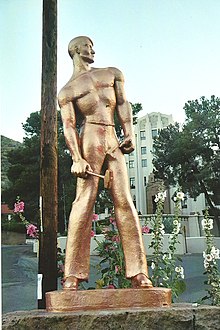New Deal artwork

New Deal artwork is an umbrella term used to describe the creative output organized and funded by the Roosevelt administration's New Deal response to the Great Depression.[2] This work produced between 1933 and 1942[2] ranges in content and form from Dorothea Lange's photographs for the Farm Security Administration to the Coit Tower murals to the library-etiquette posters from the Federal Art Project to the architecture of the Solomon Courthouse in Nashville, Tennessee. The New Deal sought to "democratize the arts" and is credited with creating a "great body of distinguished work and fostering a national aesthetic."[3]
Background
While work of this era is sometimes called “WPA art” the architecture and the creative arts groups of the
(Note: New Deal historiographic work is a separate, albeit overlapping, topic that includes “the Historic American Buildings Survey (HABS), the Index of American Design, the establishment of the National Archives, the historic restoration work of the Civilian Conservation Corps, the WPA’s Historical Records Survey, and the hundreds of WPA books and writings covering the histories of states, towns, folklore, art, African Americans, American Indians, Latinos, and more.”)[5]
Collectively, the artists of the New Deal produced a vast archive:
The New Deal arts programs emphasized
Both the Whitney Museum of Art and the Museum of Modern Art created gallery shows in 1936 showcasing works by Treasury and WPA artists, respectively, that had been commissioned through the federal programs.[12] The New York Times reported that the Whitney show “abounds in vitality” and was especially complementary about the sculpture, including William Zorach’s Benjamin Franklin and Heinz Warneke’s Bears.[13]
See also
- List of Federal Art Project artists
- List of New Deal murals
- List of United States post office murals
- List of New Deal sculpture
Further reading
- O'Connor, Francis V. (1972). The New Deal Art Projects; an Anthology of Memoirs. Smithsonian Institution.
- Kalfatovic, Martin R. (1994). The New Deal fine arts projects : a bibliography, 1933-1992. Metuchen, N.J.: Scarecrow Press. OCLC 28631740.
References
- ^ ""Copper Miner" Sculpture by R. Phillips Sanderson". University of Arizona Libraries, Special Collections. Retrieved 2022-10-02.
- ^ a b Legal Title to Art Work Produced Under the 1930s and 1940s New Deal Administration. U.S. General Services Administration. 2005.
- ^ OCLC 907924703.
- ^ Duxbury, Kathleen (2016-07-27). "The Lost Artworks of the Civilian Conservation Corps". Living New Deal. Retrieved 2022-10-02.
- ^ a b "Historic Sites Act (1935)". Living New Deal. Retrieved 2022-10-02.
- OCLC 8223038.
- OCLC 227919759.
- ^ Writers' Program (U.S.) (1942). Catalogue, WPA Writers' Program publications, the American guide series, the American life series. September 1941. Washington: U. S. Govt. print. off.
- OCLC 946462658.
- JSTOR 1903257.
- ^ Leuchtenburg, William E. (1995). The FDR Years: On Roosevelt and his Legacy. New York: Columbia University Press. p. 243.
- ^ Richmond, Lauren (May 2014). Defining the American Vision: The Whitney Museum of American Art's Role in Changing the Landscape of American Art History (Honors thesis). Wellesley College.
- ^ Jewell, Edward Alden (1936-10-06). "MURALS FEATURE TREASURY EXHIBIT; Works Designed for Public Buildings on View Today at Whitney Museum". The New York Times. Retrieved 2022-10-02.

